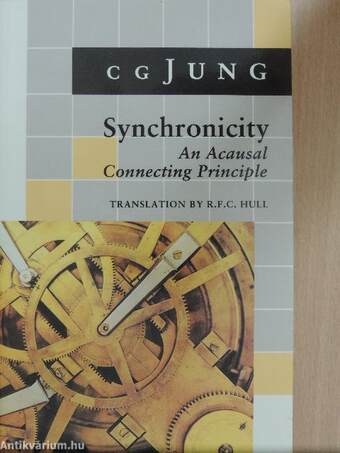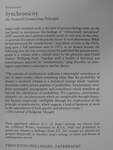1.066.801
kiadvánnyal nyújtjuk Magyarország legnagyobb antikvár könyv-kínálatát

VISSZA
A TETEJÉRE
JAVASLATOKÉszre-
vételek
Synchronicity
An Acausal Connecting Principle
| Kiadó: | Princeton University Press |
|---|---|
| Kiadás helye: | New Jersey |
| Kiadás éve: | |
| Kötés típusa: | Ragasztott papírkötés |
| Oldalszám: | 135 oldal |
| Sorozatcím: | Bollingen Series |
| Kötetszám: | 10 |
| Nyelv: | Angol |
| Méret: | 22 cm x 14 cm |
| ISBN: | 0-691-01-794-8 |
naponta értesítjük a beérkező friss
kiadványokról
naponta értesítjük a beérkező friss
kiadványokról
Fülszöveg
Synchronicity
An Acausal Connecting Principle
Jung's only extended work in the field of parapsychology aims, on the
one hand, to incorporate the findings of "extrasensory perception"
(ESP) research into a general scientific point of view and, on the other,
to ascertain the nature of the psychic factor in such phenomena. While
he had advanced the "synchronicity" hypothesis as early as the 1920s,
Jung gave a full statement only in 1951, in an Eranos lecture; the
following year (he was seventy-seven) he published the present mono-
graph in a volume with a related study by the physicist (and Nobel
winner) Wolfgang Pauli. Together with a wealth of historical and
contemporary material on " synchronicity,w Jung describes an astro-
logical experiment conducted to test his theory.
"The concept of synchronicity indicates a meaningful coincidence of
two or more events, where something other than the probability of
chance is involved. Chance is a statistical concept which... Tovább
Fülszöveg
Synchronicity
An Acausal Connecting Principle
Jung's only extended work in the field of parapsychology aims, on the
one hand, to incorporate the findings of "extrasensory perception"
(ESP) research into a general scientific point of view and, on the other,
to ascertain the nature of the psychic factor in such phenomena. While
he had advanced the "synchronicity" hypothesis as early as the 1920s,
Jung gave a full statement only in 1951, in an Eranos lecture; the
following year (he was seventy-seven) he published the present mono-
graph in a volume with a related study by the physicist (and Nobel
winner) Wolfgang Pauli. Together with a wealth of historical and
contemporary material on " synchronicity,w Jung describes an astro-
logical experiment conducted to test his theory.
"The concept of synchronicity indicates a meaningful coincidence of
two or more events, where something other than the probability of
chance is involved. Chance is a statistical concept which 'explains*
deviations within certain patterns of probability. Synchronicity eluci-
dates meaningful arrangements and coincidence which somehow go
beyond the calculations of probability. Pre-cognition, clairvoyance,
telepathy, etc. are phenomena which are inexplicable through chance,
but become empirically intelligible through the employment of the
principle of synchronicity, which suggests a kind of harmony at work
in the interrelation of both psychic and physical events."
—The Journal of Religious Thought
These paperback editions of C. G. Jung's writings are chosen from
the Collected Works, translated by R.F.C. Hull and published in
twenty-one volumes as Bollingen Series XX. The excerpts are selected and
grouped thematically to introduce Jung's writings on issues and themes of
contemporary interest.
PRINCETON/BOLLINGEN PAPERBACKS Vissza
Témakörök
- Pszichológia > Alkalmazott lélektan > Pszichotechnika > Pszichoanalitika > Egyéb
- Pszichológia > Pszichológia története, módszerei > Tanulmányok
- Pszichológia > Idegennyelvű > Angol
- Pszichológia > Parapszichológia > Egyéb
- Paratudományok > Dimenziók és univerzum > Parapszichológia
- Idegennyelv > Idegennyelvű könyvek > Angol > Paratudományok > Egyéb
- Idegennyelv > Idegennyelvű könyvek > Angol > Pszichológia
C. G. Jung
C. G. Jung műveinek az Antikvarium.hu-n kapható vagy előjegyezhető listáját itt tekintheti meg: C. G. Jung könyvek, művekMegvásárolható példányok
Nincs megvásárolható példány
A könyv összes megrendelhető példánya elfogyott. Ha kívánja, előjegyezheti a könyvet, és amint a könyv egy újabb példánya elérhető lesz, értesítjük.







